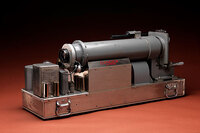It may eventually be possible to tell via TeslaTouch, a new tactile technology for touchscreens (say that ten times fast). Chris Harrison, a Ph.D. student at Carnegie Mellon University is working with Disney Research to create a new method of electronic screen production, utilizing electrical impulses to simulate different sensations. According to the CNN Tech Blog:
The touch screen is made up of three layers. A glass plate, topped with a transparent electrode and an insulator, is what people touch. To simulate friction and texture, the electrode creates small electrical fields in the insulation layer. These fields oscillate between positive and negative charges, creating those sensations.
Such technology could make it possible to feel computer keys on a touchscreen, allowing users to “touch type” rather than look at the screen’s keyboard. Rubber, sandpaper, and even cat fur could be simulated. Additionally, the technology can imitate the “weight” of files or folders, depending on their size. This could allow users to feel how long a file or folder will take to transfer from one location to another.
For more information, see the TeslaTouch project page.

